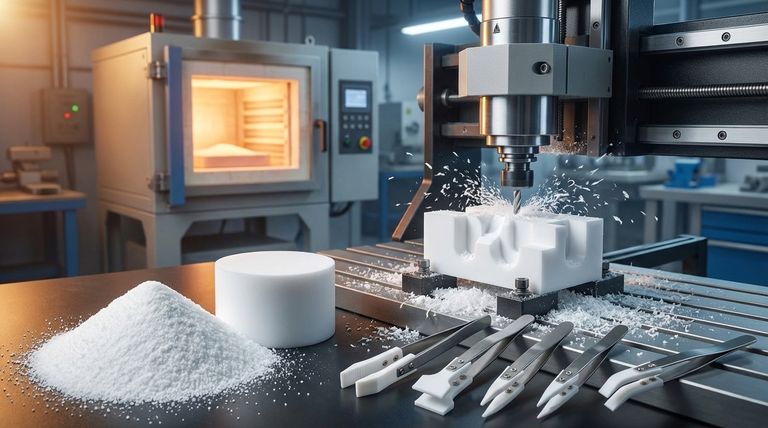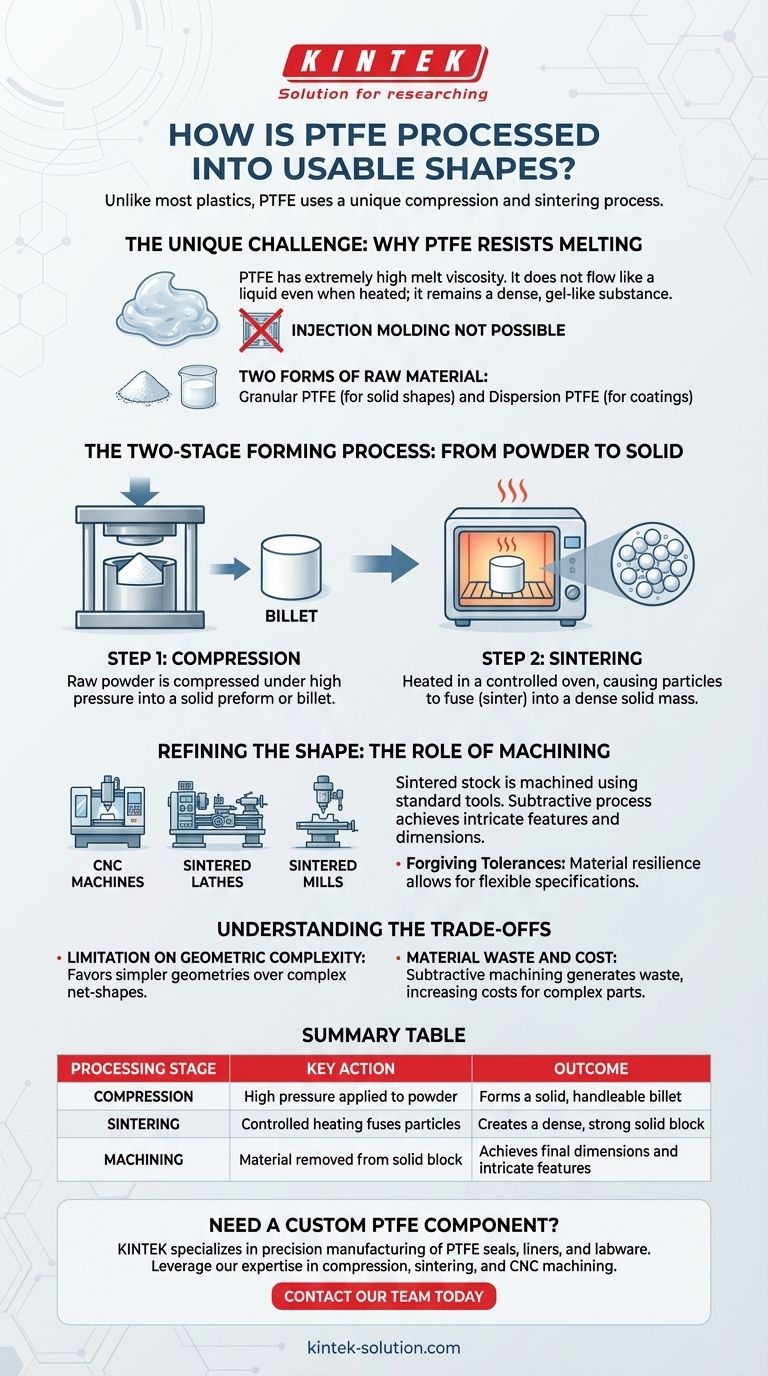Unlike most plastics, Polytetrafluoroethylene (PTFE) cannot be processed by melting. Instead, the raw PTFE powder is first compressed into a solid block, known as a billet, and then heated in a process called sintering, which fuses the particles together. This solid form is then easily machined into its final, usable shape using standard cutting tools.
The core takeaway is that processing PTFE is a multi-stage method more akin to powder metallurgy than traditional plastic molding. This fundamental difference—compressing and sintering a powder rather than melting and injecting a liquid—directly influences part design, complexity, and cost.

The Unique Challenge: Why PTFE Resists Melting
To understand how PTFE is shaped, you must first understand its fundamental properties. It behaves very differently from common polymers like ABS or polycarbonate.
A Polymer That Won't Flow
PTFE has an extremely high melt viscosity, meaning even at temperatures where it technically begins to melt, it doesn't flow like a liquid. It remains a very dense, gel-like substance.
Because it cannot be liquefied and injected into a mold, traditional high-volume methods like injection molding are not possible. The material must be formed while it is in a solid state.
The Two Forms of Raw Material
The process begins with PTFE created through one of two polymerization methods, which yield different raw forms for different applications.
Suspension polymerization creates granular PTFE grains or pellets. This is the material used to create solid shapes like rods, sheets, and tubes.
Dispersion polymerization produces a fine, milky paste. This form is primarily used to create thin coatings for applications like non-stick cookware.
The Two-Stage Forming Process: From Powder to Solid
Creating a solid PTFE component is a sequential process that builds a dense, usable part from loose powder.
Step 1: Compression
The raw, granular PTFE powder is poured into a mold and subjected to high pressure. This compacts the powder into a solid "preform" or billet that is strong enough to be handled.
This initial shape is a simple, rough approximation of the final part, such as a solid cylinder, block, or thick-walled tube.
Step 2: Sintering
The compressed billet is removed from the mold and heated in a carefully controlled oven. The temperature is brought high enough to cause the individual PTFE particles to fuse, or sinter, into a single, solid mass.
This is the most critical step, as it locks the particles together, giving the material its final strength and density without ever having to melt it.
Refining the Shape: The Role of Machining
Once a sintered billet is produced, it serves as the raw stock material for creating the final component.
Subtractive Manufacturing is Key
PTFE is remarkably easy to machine using standard equipment. CNC machines, lathes, mills, and drills can all cut PTFE cleanly and precisely.
This subtractive process, where material is removed from a solid block, is how intricate features, tight tolerances, and final dimensions are achieved.
Forgiving Tolerances
Due to PTFE's natural resilience and low friction, it can often conform to its working environment. This means that while extremely close tolerances can be achieved, they are often not necessary for the part to function correctly.
Because of this, stock PTFE shapes are often sold slightly oversized, allowing fabricators to easily machine them down to exact specifications.
Understanding the Trade-offs
The compression, sintering, and machining process has direct consequences for design and manufacturing.
Limitation on Geometric Complexity
Because PTFE isn't injection molded, creating highly complex, net-shape parts is difficult and expensive. The process favors simpler geometries that can be easily machined from standard stock shapes like rods and sheets.
Material Waste and Cost
Subtractive machining, by its nature, generates waste material. For complex parts requiring significant material removal, this can increase the overall cost compared to a molded plastic part where only the necessary material is used.
How to Apply This to Your Project
Choosing the right approach depends entirely on your final goal.
- If your primary focus is a simple component like a gasket, seal, or bushing: Standard, pre-formed PTFE rods and sheets are ideal stock materials for simple machining.
- If your primary focus is a complex, custom-machined part: Design your component with subtractive manufacturing in mind, and be aware that costs will scale with complexity and material waste.
- If your primary focus is a surface coating: You need PTFE produced via the dispersion method, which is applied as a liquid or fine powder and then cured with heat.
Understanding this unique manufacturing path is the key to effectively leveraging PTFE's exceptional properties while respecting its practical design constraints.
Summary Table:
| Processing Stage | Key Action | Outcome |
|---|---|---|
| Compression | High pressure applied to powder | Forms a solid, handleable billet |
| Sintering | Controlled heating fuses particles | Creates a dense, strong solid block |
| Machining | Material removed from solid block | Achieves final dimensions and intricate features |
Need a custom PTFE component? KINTEK specializes in precision manufacturing of PTFE seals, liners, labware, and more for the semiconductor, medical, and industrial sectors. Our expertise in compression, sintering, and CNC machining ensures your parts meet exact specifications, from prototypes to high-volume orders. Contact our team today to discuss your project and leverage our material knowledge for your application.
Visual Guide

Related Products
- Custom PTFE Parts Manufacturer for Teflon Parts and PTFE Tweezers
- Custom PTFE Parts Manufacturer for Teflon Containers and Components
- Customizable PTFE Rods for Advanced Industrial Applications
- Custom PTFE Teflon Balls for Advanced Industrial Applications
- Custom PTFE Volumetric Flasks for Advanced Scientific and Industrial Use
People Also Ask
- What are the unique properties of PTFE? The 3 Pillars Driving Demand for High-Performance Parts
- What are the unique properties of PTFE? Unlock Unmatched Performance in Demanding Applications
- What chemical processing applications involve PTFE-machined parts? Essential Components for Corrosive & High-Purity Systems
- What challenges arise when machining PTFE (Teflon)? Overcome Softness, Heat, and Instability
- What finishing techniques are effective for machined Teflon parts? Achieve Functional Performance and Dimensional Stability



















